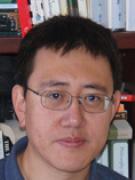Event Date:
Event Location:
- Webb Hall 1100
Dr. Maosheng Miao, of Cal State Northridge, will give this week's Speakers Club talk entitled Chemistry Stories on the Journey to the Center of the Earth on Thursday, December 3 at 2:00 PM in Webb Hall 1100.
Abstract:
The exotic and thrilling species, including giant mushrooms, prehistoric human and T-Rex in “The Journey to the Center of the Earth” do not exist because the interior of the Earth has extremely high pressure and temperature far beyond the condition for any life forms. However, such extreme condition may accommodate something that is real and even more fascinating than a living T-Rex. Using computer simulations based on quantum mechanics, we will show that the condition at Earth’s mantle and core not only can cause the structural change of minerals but also alter the chemistry of matter at very fundamental level, namely the atomic shell structure and hence the periodicity and reactivity of atoms. The periodicity of the elements and the non-reactivity of the inner-shell electrons are two related principles of chemistry, rooted in the atomic shell structure. Within compounds, Group I elements such as Li, Na K and Rb, for example, tend to loose only the electron at the outmost-shell, and their chemical properties differ completely from the elements at the right side of the periodic table. These general rules govern our understanding of chemical structures and reactions. We demonstrate that under high pressure, the above doctrines can be broken. Both the inner shell electrons and the outer shell empty orbitals of elements such as Cesium and other elements can be involved in chemical reactions quite exotic compared to low-pressure possibilities. While losing its inner shell electrons, Cesium can behave like Xenon for example. Furthermore, we show that the “empty space” inside the compounds may behave as an atom hungering for electrons under high pressure, a true T-Rex hidden in the interior of a rocky planet. Their existence may help to explain some key puzzles in Earth science, for example the missing Xenon problem. Other geochemical unresolved questions such as the exact nature of the ‘light’ element in the Earth’s core, the abundance of He, and radiogenic K and U in the core and possible new silicate high-pressure polymorphs can all be informed by changes in the electron energy levels due to the ambient high pressures (200-360 GPa) in the Earth’s deep interior. The discovery of superearths, that is exoplanets more massive than the Earth demonstrates that much remains to be learned regarding the effects of high static pressure on geomaterials.

